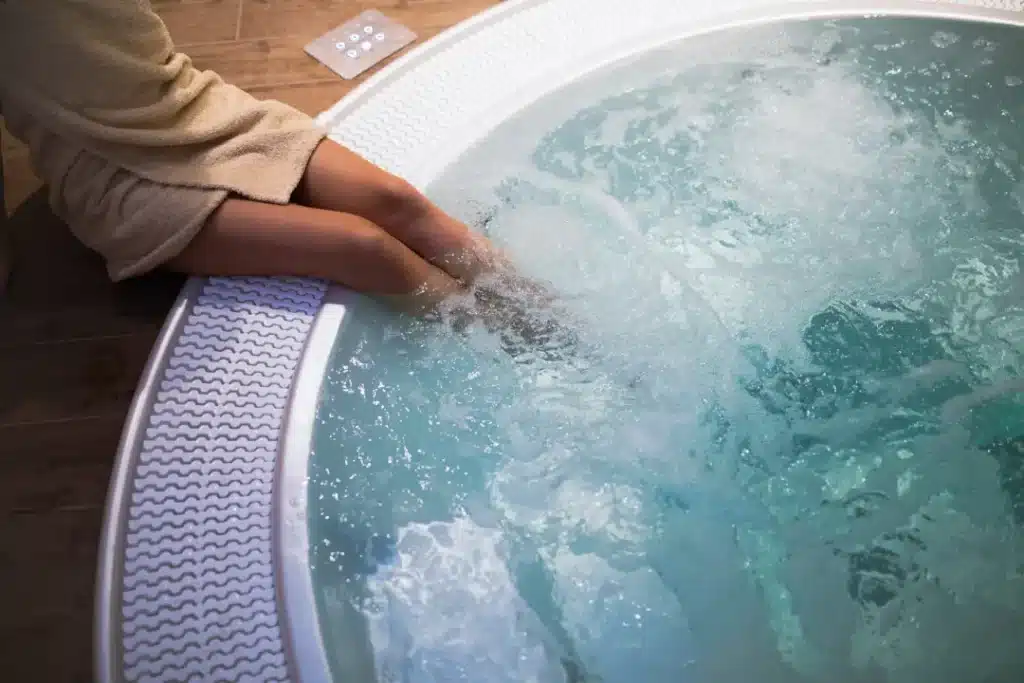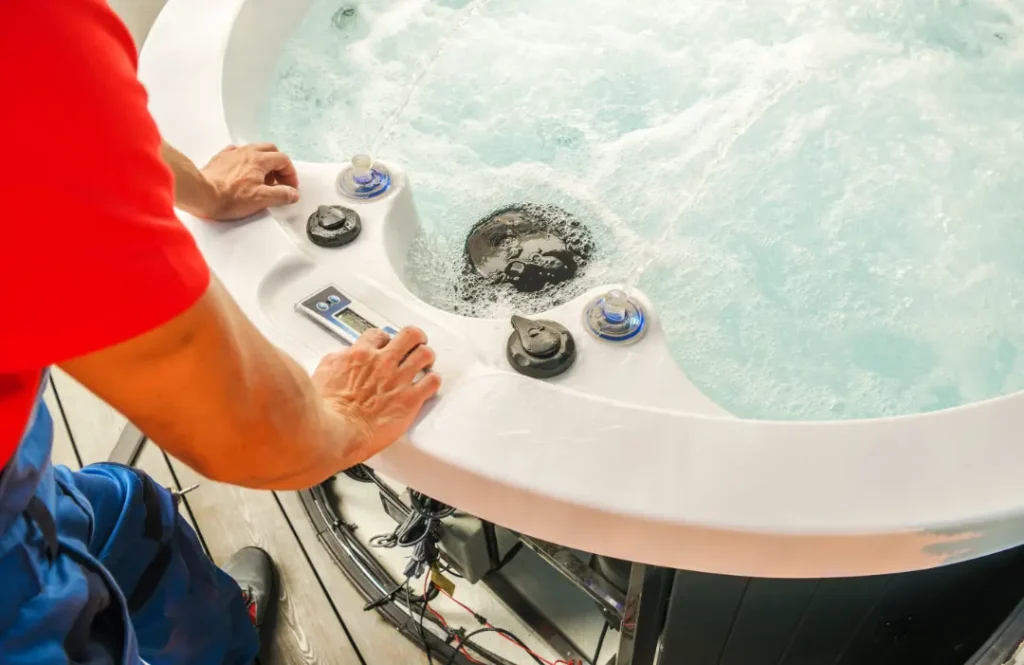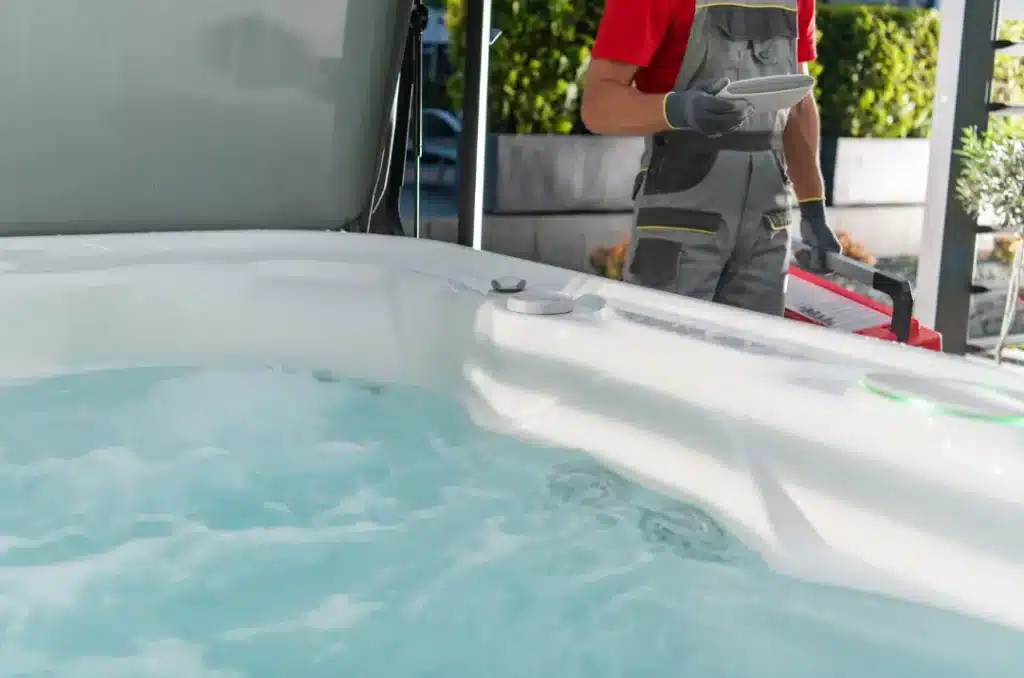Wondering why hot tub is foamy? Hot tub foam usually comes from a build-up of soaps, lotions, and other debris. This article will help you understand the causes and provide easy steps to eliminate and prevent foam in your hot tub.
Key Takeaways
- Foamy hot tub water primarily results from the buildup of surfactants caused by personal care products, food and drink contamination, and unbalanced water chemistry.
- Regular maintenance, including water chemistry testing and filter cleaning, is crucial to effectively prevent and diagnose hot tub foam issues.
- To eliminate foam, consider rebalancing water chemistry, using anti-foaming chemicals, or draining and refilling the hot tub with fresh water.
Hot Tub Foam: Is It Normal?
If you’ve noticed foam in your hot tub, you might be wondering—should I be worried? Foam isn’t just a surface issue; it’s a signal that something’s off with your water chemistry. But what’s causing this bubbly mess?
At the heart of the problem are surfactants, compounds that help oils mix with water. When air meets these surfactants in the water, bubbles form, eventually creating a layer of foam floating on the surface. The more surfactants there are, the longer those bubbles stick around.
This is why controlling what goes into your hot tub is important. Everyday products like lotions, soaps, and oils are the usual suspects behind foam buildup. Keeping them out can make a big difference in keeping your hot tub foam-free.
Now that you’ve got the basics let’s break down the common causes of foamy hot tub water.
Common Causes of Foamy Hot Tub Water
Foamy hot tub water is more common than you might think, and it usually results from a buildup of certain substances in the water. Personal care products like soap residue, body oils, and lotions are often the main culprits. Even food and drink spills can sneak in and add to the problem. When your water chemistry is off balance, it can make the situation worse. Let’s take a closer look at these factors and how they lead to foamy water.

Soap Residue and Detergents
One of the most common ways surfactants enter hot tub water is through residual soap from skin, hair products, and detergents. When you or your guests enter the hot tub without rinsing off thoroughly, these surfactants make their way into the water. Soap residue on the skin and bathing suits is a primary contributor to foam formation.
Over time, these surfactants can build up and increase the total dissolved solids (TDS) in your hot tub water. TDS creates a film that traps air and forms bubbles. To mitigate this, consider using less laundry detergent when laundering swimsuits and ensure an extra rinse cycle to remove any lingering soap.
Body Oils and Lotions
Personal care products like lotions and body oils are significant sources of surfactants in hot tubs. These products are designed to stay on your skin, so naturally, they accumulate in the water over time. Oils and lotions are often the cause of foamy water in hot tubs, and their buildup is the most frequent reason for this issue.
Prevent this by showering before entering the hot tub. It helps remove lotions, shampoos, and other chemicals from your skin, reducing the amount of surfactants introduced into the water. Enzyme-based cleaners also assist in breaking down oils and reducing foam.
Food and Drink Contamination
Hosting a hot tub party can be fun, but it can also lead to spills from food and drinks, introducing organic material and other contaminants into the water. These spills can also increase the total dissolved solids, adversely affecting water balance and clarity.
Keep food and drinks away from the hot tub or use spill-proof containers to avoid this.
Unbalanced Water Chemistry
When the water’s chemical levels are off, particularly if the calcium hardness is too low, problems can result. Low calcium makes the water more corrosive, which could harm the hot tub and its equipment. Using improperly mixed or low-quality chemicals only makes matters worse, often resulting in foam buildup.
Another issue is biofilm buildup, which reduces the effectiveness of your sanitizer and allows surfactants to accumulate, causing foam. Regularly checking and adjusting your water’s pH, alkalinity, and calcium hardness will keep your hot tub water in check and help you avoid that pesky foam!
How to Diagnose Foamy Hot Tub Water
Diagnosing the underlying cause is essential before effectively treating foamy hot tub water. Start by testing and treating the water chemistry, as this is fundamental in addressing hot tub foam. If the water balance is fine, other possible causes include the causes we discussed earlier: e.g oils and lotions buildup and biofilm buildup.
Inspecting your hot tub’s filters and surfaces, as well as testing water chemistry, is also important. Organic debris like dirt, hair, and oils collected in filters can contribute to water foam.

Testing Water Chemistry
Key parameters to test include pH, alkalinity, calcium hardness, and total dissolved solids (TDS). Unbalanced water chemistry caused by low calcium levels or improper sanitizer levels can lead to increased foam formation.
If sanitizer levels are low, add more sanitizer and retest the water the next day. After refilling your hot tub, test the water and allow circulation for 24 hours before use.
Check water chemistry weekly to prevent foamy water conditions.
Inspecting Filters and Surfaces
Cleaning the hot tub filter every few weeks helps prevent foamy water. Organic debris like dirt and oils collected in filters can contribute to water foam. Maintaining filters regularly ensures they operate efficiently, keeping your hot tub water clean.
How to Get Rid of Hot Tub Foam
There are several additional solutions to get rid of foam in hot tub water, including using anti-foaming chemicals, shocking the water, or even draining and refilling the hot tub with fresh water. Here’s a breakdown of each method:
Using Anti-Foaming Chemicals
For a quick fix, anti-foaming chemicals can help reduce surface foam in your hot tub. These products work by breaking the bond between water and surfactants, giving you fast relief from foamy water.
While effective, it’s important to remember that anti-foam chemicals are a temporary solution. To maintain long-term water quality, you’ll still need to address the underlying causes.
Shocking Your Spa Water
Shocking the hot tub is a great way to eliminate the organic contaminants contributing to foaming. It helps reduce the total dissolved solids (TDS) and oxidizes impurities. Shocking your water weekly—especially after heavy use or a hot tub party—keeps sanitizer levels in check and prevents foam from forming.
This practice ensures your hot tub remains clean and well-balanced.
Draining and Refilling with Fresh Water
If foam continues to be a problem, draining and refilling the hot tub with fresh water is often the most effective solution. It’s recommended to do this every few months to maintain optimal water conditions.
After draining, wipe down the inside of your hot tub with a damp cloth. To minimize impurities, use a hose filter when refilling. Once refilled, circulate the water for at least a day and test the chemical levels to ensure a fresh, foam-free soak.
Tips to Prevent Foam Build-Up in Hot Tubs
Maintaining a foam-free hot tub involves consistent care, attention to water chemistry, and adopting preventive measures. By following a few simple steps, you can ensure your hot tub remains clean, clear, and enjoyable for every use.

Monitor and Maintain Water Chemistry
Regularly monitoring your water chemistry is the foundation of foam prevention. Ensure that:
- pH levels remain between 7.2 and 7.6 for balance.
- Chlorine levels are kept between 1 and 3 parts per million for proper sanitization.
- Total dissolved solids (TDS) are checked frequently to ensure water quality.
Additionally, draining and cleaning your hot tub every 3-4 months helps maintain cleanliness and prevent foam build-up. With these steps, you’ll be well on your way to a cleaner, foam-free hot tub experience.
Shower Before Use to Prevent Foam-Causing Contaminants
Before entering the hot tub, a quick shower can help prevent foam. Washing off oils, lotions, and cosmetics reduces the introduction of surfactants, substances responsible for foam formation. This simple habit ensures a cleaner, more enjoyable soak and keeps the water in your hot tub clearer for longer.
Rinse Bathing Suits Properly
Swimsuits can carry detergent residues that easily contribute to foam in your hot tub water. To avoid this, rinse bathing suits in cold water without using detergent. By doing so, you reduce the risk of transferring unwanted soap residues into the water, keeping it free from foam.
Perform Regular Maintenance and Cleaning
Routine maintenance is essential for foam prevention. Stick to high-quality hot tub chemicals to avoid water balance issues that can increase the risk of foam. Key tasks include:
- Cleaning filters regularly to ensure they work effectively.
- Balancing water chemistry weekly to keep everything in check.
- Shocking the water weekly or after heavy use or parties to eliminate contaminants that could lead to foam formation.
By incorporating these maintenance practices, you’ll keep your hot tub clean, clear, and inviting for all your soaks.
Experience Top-Notch Hot Tub Care with Action Spa Repairs!
Let’s face it: a bubbling spa should be a place of comfort, not frustration. Action Spa Repairs is the trusted hot tub repair expert in San Diego, providing flawless hot tub services since 1993. With over 30 years of experience under our belts, we truly understand the unique needs of every hot tub owner. Our technicians benefit from cutting-edge remote support, ensuring your repairs are swift and efficient. And with a well-stocked warehouse of parts for most brands, we’re ready to tackle your repair needs so you can get back to enjoying your oasis sooner!
When it comes to hot tub repairs, we don’t just fix problems—we deliver unrivaled service. Whether you’re dealing with leaks, a heater malfunction, or the need for a jet replacement, our skilled team has the expertise to handle it all, regardless of the brand or model of your hot tub. We pride ourselves on our ability to quickly identify and solve issues, giving you the peace of mind that comes from knowing your spa is in the hands of seasoned professionals.
Contact us today to schedule a consultation.
Conclusion
Foamy hot tub water can be a frustrating issue, but with the right knowledge and maintenance practices, it’s entirely manageable. Understanding the causes, such as soap residue, body oils, food and drink contamination, and unbalanced water chemistry, is the first step toward prevention and treatment. Regularly testing and balancing your water chemistry, cleaning filters, and using appropriate chemicals are vital to maintaining a quality hot tub experience.
By following the steps outlined in this guide, you can effectively diagnose, eliminate, and prevent foam build-up. Remember, consistent maintenance and proper care are key to enjoying a clean and relaxing hot tub. And when in doubt, professional services like Action Spa Repair are always available to ensure your hot tub remains in top condition.
Frequently Asked Questions
Why is my hot tub water foamy?
Foamy hot tub water is typically due to surfactants like soap residue, body oils, and unbalanced water chemistry. To resolve this, ensure proper water balance and reduce the introduction of contaminants.
What should I do if my hot tub foam persists despite using anti-foaming chemicals?
To eliminate persistent hot tub foam, recheck and rebalance your water chemistry, shock the spa, or drain and refill it with fresh water. Regular maintenance is key to preventing foam in the future.
How can I prevent hot tub foam from forming?
To prevent hot tub foam, check your hot tub water weekly and maintain balanced water chemistry. Additionally, minimize the use of laundry detergent when washing your swimsuits and rinse them thoroughly before entering the hot tub. This helps reduce surface tension caused by soap residues, keeping your water clean and foam-free.
